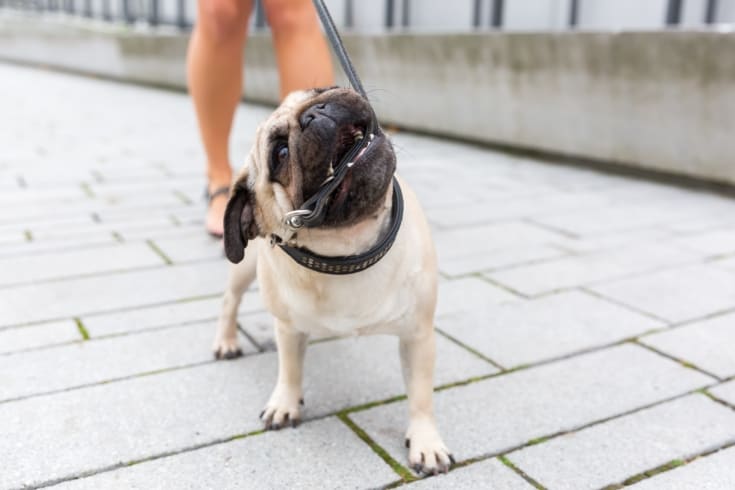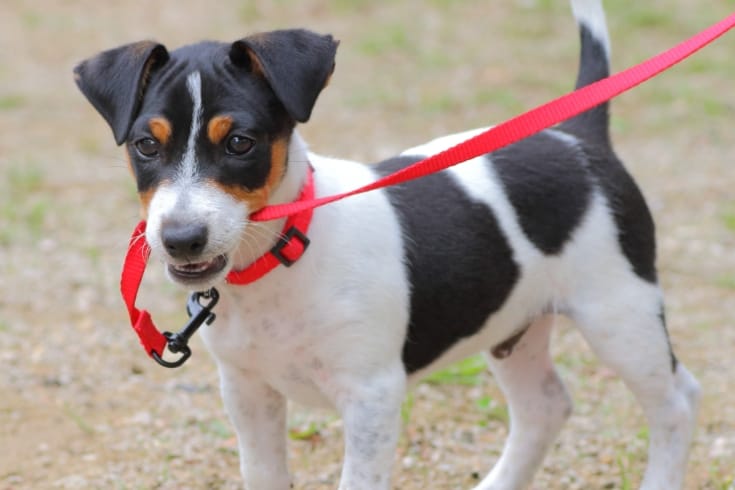A dog that bites on his leash is a nightmare to walk, replacement leashes are expensive, and if the dog bites right through his leash and gets loose, he could cause an accident.
So, leash biting is a habit you need to break.
But why do dogs bite on their leash? How can you stop that annoying habit? And what steps can you take to prevent it?
Keep reading for our top tips on how to stop your dog from biting on his leash for good!
Why Does My Dog Bite His Leash?

Leash biting is a common and extremely frustrating problem that many dog owners experience.
Tugging and biting on the leash is often a phase that lots of puppies go through. The pup usually grows out of leash biting with persistent, reward-based training. However, in some cases, the habit becomes an ingrained behavior that persists into adulthood.
Although leash biting is often assumed to be bad behavior, your canine companion often bites his leash in response to frustration or not fully understanding how to walk on a loose leash.
A leash biter is usually an excitable, playful, young dog that hasn’t got to grips with loose leash walking.
Normal Behavior
Mouthing, biting, and tugging on things are natural behaviors that dogs exhibit when they’re excited. An excited dog simply uses his leash as a handy tug toy.
Generally, playful dogs struggle to burn off excess energy and are prone to biting their leash.
Attention Seeking Behavior
Many dogs bite and chew on their leash to get your attention.
Think about it from your dog’s point of view. When loose leash walking in an orderly, well-behaved manner, no one pays him any attention. However, when the dog acts out, he’s immediately the center of attention. Unfortunately, negative attention and an irritated handler are better options for many pups than receiving no attention.
Overarousal

Excitable dogs that tend to go over the top in certain situations often find that biting their leash is the perfect way to release tension.
For example, leash biters are often seen in shelters and rescues when it’s time for exercise. When the dog’s leash is clipped on, he knows it’s time for the boredom of being confined to his kennel or his run to end.
In extreme cases, overexcited dogs can become highly aggressive, attacking their leash and even biting their handler. In those cases, dealing with that behavior is essential for everyone’s safety.
Something to Carry
Many dogs, especially retriever breeds, love to carry something in their mouths, and that can be their leash.
Thick rope leashes are especially popular with dogs that love to have something to carry around.
It’s Your Fault!
Make sure you’re practicing loose leash walking and not inadvertently pulling back on your dog’s harness.
Many dogs become irritated by unwanted pressure on their harness and will start biting at the leash out of frustration.
Never tease your dog by dangling the leash right in front of his face! That’s only going to encourage your furry friend to grab the leash and confuse him.
How to Stop Your Dog Leash Biting

If you have a leash biter, the good news for you is that there are several highly effective ways of curing that undesirable behavior.
Don’t Punish Your Pup!
Before you begin teaching your dog not to chew his leash, take a moment. Yes, leash chewing, biting, and jumping up are bad habits that can be incredibly irritating, but you must resist the urge to scold or reprimand your dog.
Your dog is probably excited at the prospect of accompanying his beloved owner on a walk, and punishing your dog for expressing his delight is confusing for him. The last thing you want is to make your dog afraid of wearing his leash. That can make your pet reluctant to allow you to put on his harness and leash, creating even more problems.
1. Chill Out!
The first step is to teach your dog to relax when he sees his leash.
Start by touching the leash without actually picking it up. If your dog stays calm, reward him with a high-value treat and verbal praise. Now, try moving the leash. Continue to reward your dog for remaining quiet and calm.
If all goes well, pick up the leash and move it around your dog. If your furry friend stays relaxed and calm, continue rewarding him with a handful of treats.
2. Attach the Leash

Provided your dog remains relaxed and calm when he sees you holding the leash, clip the leash to your pet’s harness.
Insist that your dog remains sitting.
This step trains your dog to see his leash as a cue for reward and relaxation, not a trigger for excitement, biting, and mouthing.
Remove the leash and reward your dog again.
3. Heel!
Now, you want your dog to learn to walk calmly to heel beside you while off-leash.
Use a small area inside your home or in a fenced yard where there aren’t any distractions. Have your dog walk to heel, offering your pet frequent rewards for his calm behavior.
4. Leash-On!
Start by rewarding your dog for relaxing at the sight of his leash.
Have your dog sit, and clip on his leash. As soon as the leash is attached, cue your dog to walk to heel.
If the dog begins biting or tugging on his leash, you must immediately stand still and ignore him. That stops the walk, effectively stopping your dog’s fun and your interaction with him. As soon as your dog lets go of the leash, reward him and ask him to walk to heel.
That’s Not Working!

Although those tips are generally effective in curing the leash-biting habit, they don’t work for all dogs.
So, what’s the alternative?
Something to Carry
If your dog grabs the leash because he needs something to carry, offer him an alternative. That could be your dog’s favorite tug toy, a rubber ball, a KONG, or even an old leash!
The idea is simple. If your dog already has his mouth full, he’ll be much less likely to bite his leash.
Don’t Pull Back!
If your dog regards his leash as a tug toy, you can foil his game by simply refusing to pull back. Your lack of participation will quickly take the fun out of your pet’s tug-of-war game.
For this strategy to work well, you need to use a dragline in addition to your dog’s regular leash. As soon as your dog grabs his leash, pick up the dragline and let go of the leash.
Remember to tie knots in your dragline so that it can’t slip through your fingers, allowing your dog to escape. If your dog grabs the dragline, drop that and pick up the leash instead. The dog’s fun game of tug stops whenever you drop the line or leash.
Final Thoughts
Did you enjoy our tips on preventing your dog from biting his leash while out on walks? If you did, please remember to share the article.
Dogs generally bite or chew their leashes out of frustration, overexcitement, or because they need something to carry while walking.
Use the positive reinforcement technique described above to teach your dog to relax at the sight of his leash. Don’t get into a game of tug with your dog when he’s grabbing his leash; offer your mouthy pup something to carry as an alternative to grabbing his leash.
How did you do? Tell us in the comments box below!
